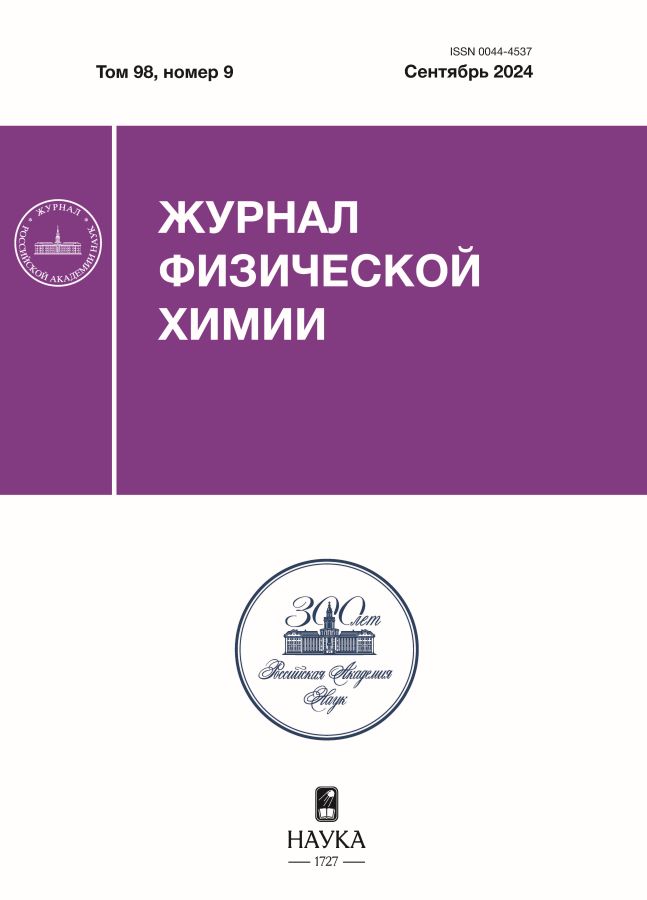Термодинамические свойства титанатов иттрия, Y2Ti2O7, и европия, Eu2Ti2O7, в области температур 7–1800 К
- 作者: Гагарин П.Г.1, Гуськов А.В.1, Хорошилов А.В.1, Гуськов В.Н.1, Кондратьева О.Н.1, Рюмин М.А.1, Никифорова Г.Е.1, Гавричев К.С.1
-
隶属关系:
- Институт общей и неорганической химии им. Н. С. Курнакова Российской академии наук
- 期: 卷 98, 编号 9 (2024)
- 页面: 5-16
- 栏目: 100-ЛЕТИЮ ЛАБОРАТОРИИ ХИМИЧЕСКОЙ ТЕРМОДИНАМИКИ МГУ
- ##submission.dateSubmitted##: 23.03.2025
- ##submission.datePublished##: 30.12.2024
- URL: https://rjonco.com/0044-4537/article/view/677586
- DOI: https://doi.org/10.31857/S0044453724090012
- EDN: https://elibrary.ru/OOOUDU
- ID: 677586
如何引用文章
详细
Изучена температурная зависимость теплоемкости Y2Ti2O7 и Eu2Ti2O7 со структурой пирохлора в интервале температур 7–1800 К. Подтверждено существование небольшой пологой аномалии теплоемкости у титаната европия в интервале 10–60 К. Рассчитаны термодинамические свойства (энтропия, изменение энтальпии и приведенной энергии Гиббса). На основании результатов расчета энергии Гиббса образования из оксидов обоих титанатов сделан вывод об их термодинамической стабильности в области высоких температур.
关键词
全文:
作者简介
П. Гагарин
Институт общей и неорганической химии им. Н. С. Курнакова Российской академии наук
编辑信件的主要联系方式.
Email: gagarin@igic.ras.ru
俄罗斯联邦
А. Гуськов
Институт общей и неорганической химии им. Н. С. Курнакова Российской академии наук
Email: gagarin@igic.ras.ru
俄罗斯联邦
А. Хорошилов
Институт общей и неорганической химии им. Н. С. Курнакова Российской академии наук
Email: gagarin@igic.ras.ru
俄罗斯联邦
В. Гуськов
Институт общей и неорганической химии им. Н. С. Курнакова Российской академии наук
Email: gagarin@igic.ras.ru
俄罗斯联邦
О. Кондратьева
Институт общей и неорганической химии им. Н. С. Курнакова Российской академии наук
Email: gagarin@igic.ras.ru
俄罗斯联邦
М. Рюмин
Институт общей и неорганической химии им. Н. С. Курнакова Российской академии наук
Email: gagarin@igic.ras.ru
俄罗斯联邦
Г. Никифорова
Институт общей и неорганической химии им. Н. С. Курнакова Российской академии наук
Email: gagarin@igic.ras.ru
俄罗斯联邦
К. Гавричев
Институт общей и неорганической химии им. Н. С. Курнакова Российской академии наук
Email: gagarin@igic.ras.ru
俄罗斯联邦
参考
- Kramer S.A., Tuller H.L. // Solid State Ionics. 1995. V.82. P. 15. https://doi.org/10.1016/0167-2738(95)00156-Z.
- Norby T. // J. Mater. Chem. 2001. V.11. P. 11. https://doi.org/10.1039/B003463K.
- Wang Z., Wang X., Zhou G., et al.// J. Europ. Ceram. Soc. 2019. V.39. P. 3229. https://doi.org/10.1016/j.jeurceramsoc.2019.04.018.
- Saif M., Shebl M., Mbarek A., et al. // J. Photochem. Photobiol., A: Chemistry. 2015. V.301. P. 1. http://dx.doi.org/10.1016/j.jphotochem.2014.12.014
- Shi F.W., Meng X.J., Wang G.S., et al. // Phys. B: Condens. Matter. 2005. V.370. P. 277. doi: 10.1016/j.physb.2005.09.023.
- Lumpkin G.R., Pruneda M., Rios S., et al. // J. Solid State Chem. 2007. V.180. P. 1512. doi: 10.1016/j.jssc.2007.01.028.
- Vassen R., Jarligo M.O., Steinke T., et al. // Surf. Coat. Technol. 20101. V.205. P. 938. doi: 10.1016/j.surfcoat.2010.08.151
- Ren W., Trolier-McKinstry S., Randall C.A., et al. // J. Appl. Phys. 2001. V.89. P. 767. https://doi.org/10.1063/1.1328408
- Wuensch B.J., Eberman K.W., Heremans C., et al. // Solid State Ionics. 2000. V.129. P. 111. https://doi.org/10.1016/S0167-2738(99)00320-3
- Ewing R.C., Weber W.J., Lian J.. // J. Appl. Phys. 2004. V.95. P. 5949. https://doi.org/10.1063/1.1707213.
- Matteucci F., Cruciani G., Dondi M., et al. // Acta Mater. 2007. V.55. P. 2229. doi: 10.1016/j.actamat.2006.11.008.
- Subramanian M.A., Aravamudan G., Subba Rao G.V. // Prog. Solid State Chem. 1983. V.15. P. 55. https://doi.org:10.1016/0079-6786(83)90001-8.
- Cioatera N., Voinea E.A., Panaintescu E., et al. // Ceram. Int. 2016. V.42. P. 1492. http://dx.doi.org/10.1016/j.ceramint.2015.09.095.
- Dasgupta P., Jana Y.M., Nag Chattopadhyay A., et al. // J. Phys. Chem. Solids. 2007. V.68. P. 347. doi: 10.1016/j.jpcs.2006.11.022.
- Garbout A., Ben Taazayet-Belgacem I., Férid M. // J. Alloys and Compd. 2013. V.573. P. 43. http://dx.doi.org/10.1016/j.jallcom.2013.03.279.
- Farmer J.M., Boatner L.A., Chakoumakos B.C., et al. // J. Alloys Compd. 2014. V.605. P. 63. http://dx.doi.org/10.1016/j.jallcom.2014.03.153.
- Helean K.B., Ushakov S.V., Brown C.E., et al. // J. Solid State Chem. 2004. V.177. P. 1858. doi: 10.1016/j.jssc.2004.01.009
- Pruneda J.M., Artacho E. // Phys. Rev. B. 2005. V.72. P. 085107. https://doi.org/10.1103/PhysRevB.72.085107
- Johnson M.B., James D.D., Bourque A., et al. // J. Solid State Chem. 2009. V.182. P. 725. doi: 10.1016/j.jssc.2008.12.027
- Pal A., Singh A., Ghosh A.K., et al. // J. Magn. Magn. Mater. 2018. V.462. P. 1. https://doi.org/10.1016/j.jmmm.2018.04.060
- Reznitskii L.A. // Inorganic Materials. 1993. V.29. P. [Резницкий Л.А. // Неорган. материалы. 1993. Т. 29. № 9. С. 1310.]
- Kowalski P.M. // Scripta mater. 2020. V.189. P. 7. https://doi.org/10.1016/j.scriptamat.2020.07.048
- Rosen P.F., Woodfield B.F. // J. Chem. Thermodynamics. 2020. V.141. P. 105974. https://doi.org/10.1016/j.jct.2019.105974.
- Sabbah, R., Xu-wu, A., Chickos, et al. // Thermochim. Acta. 1999. V.331. P. 93–204. https://doi.org/10.1016/S0040-6031(99)00009-X
- Ryumin M.A., Nikiforova G.E., Tyurin A.V., et al. // Inorg. Mater. 2020. V. 56. P. 97. https://doi.org/0.1134/S0020168520010148 [Рюмин М.А., Никифорова Г.Е., Тюрин А.В., и др. // Неорган. материалы. 2020. Т. 56. С. 102]
- Prohaska T., Irrgeher J., Benefield J., et al. // Pure Appl. Chem. 2022. V.94. No.5. P. 573. https://doi.org/10.1515/pac-2019-0603.
- Maier C.G., Kelley K.K. // J. Am. Chem. Soc. 1932. V.54. P. 3243. doi: 10.1021/ja01347a029.
- Westrum E.F., Chirico R.D., Gruber J.B. // J. Chem. Thermodyn. 1980. V.12. P. 717. https://doi.org/10.1016/0021-9614(80)90169-X.
- Thiriet C., Konings R.J.M., Javorsky P., et al. // J. Chem. Thermodyn. 2005. V.37. P. 131. doi: 10.1016/j.jct.2004.07.031.
- Термические константы веществ. Справочник под ред. Глушко В.П. Москва 1965–1982. http: // www.chem.msu.ru.
- Könings R.J.M,. Beneš O., Kovács A., et al. // J. Phys. Chem. Ref. Data. 2014. V.43. P. 013101. doi: 10.1063/1.4825256
- Chase M.W., NIST-JANAF Thermochemical Tables, 4th ed. American Chemical Society. 1998.
- Gavrichev K.S., Gorbunov V.E., Golushina L.N., et al. // Russ. J. Phys. Chem. A. 1993. V. 67. P. 1554. [Гавричев К.С., Горбунов В.Е., Голушина Л.Н., и др. // Журн. физ. химии. 1993. Т. 67 № 8 С. 1731–1733.]
补充文件

















